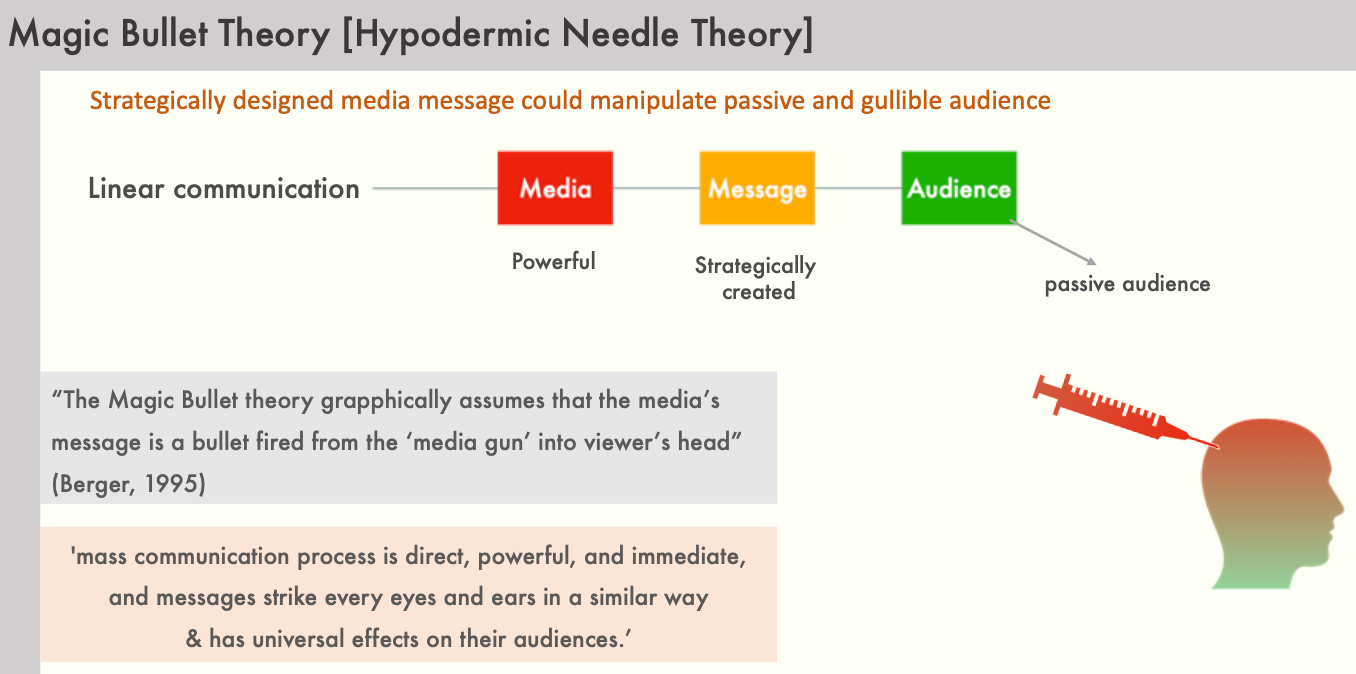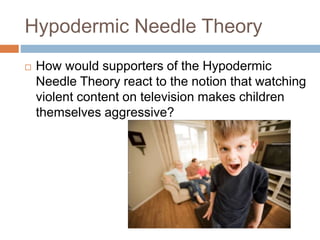The earliest definition of Hypodermic Needle Theory HNT comes from journalist Walter Lippmanns book Public Opinion saying that the growth of mass media culture has powerful effects on the minds and behavior of people Lippmann 1922. Hypodermic needle theory treats the audience as blank sheets of paper on which media messages can be written Hanes P The Advantages and Limitations of a focus on Audience in Media Studies.

Early Theories Of Mass Communication 1 Magic Bullet By Omlette A La Chantal Medium
People believe that the mass media can have a powerful effect on people and parents continue to worry about the effect of television and violent video games.

Hypodermic needle theory to children and mas media. This theory has been developed in the early 1920s with the beginning of mass media radio and cinema. Several factors contributed to. In its simple description this theory suggests that mass media can easily influence a large group of people without any challenge.
The Magic Bullet or Hypodermic Needle Theory of direct influence effects was based on early observations of the effect of mass media as used by Nazi propaganda and the effects of Hollywood in the 1930s and 1940s. The hypodermic needle theory is based on the assumption that every individual within a mass audience will behave the same way. Essentially this model holds that an intended message.
The hypodermic needle theory implied mass media had a direct immediate and powerful effect on its audiences. Although there was no actual evidence to back up his argument his claim is the earliest. Throughout the media it has been led to believe that Grand Theft Auto games lead to violent and aggressive behavior from their children however that is true if you believe that the hypodermic needle theory is true and that it effects the mind of every child playing the game.
Hypodermic Needle Theory. The hypodermic needle model also known as the hypodermic-syringe model is a model of communications also referred to as the magic bullet perspective or the transmission-belt model. The hypodermic needle theory is one of the most famous theories that analyzed the relationship between audience and media.
In accordance with this theory the mass media plays a crucial role in shaping and reflecting public opinion. How is the Magic Bullet model similar to the hypodermic needle model. Theories of Mass Media The Magic Bullet Theory -- or The Hypodermic Needle Theory posits that the mass media have a direct immediate and powerful effect just like a bullet on the watchers of TV and it has a puissant impact in behavioral changes on viewers.
5 fIn the indigenous setting the people or masses are powerless to. The mass media in the 1940s and 1950s were perceived as a powerful influence on behavior change. The magic bullet or hypodermic needle theory of direct influence effects was based on early observations of the effect of mass media as used by Nazi propaganda and the effects of Hollywood in the 1930s and 1940sIt suggests that the media injects its messages straight into the passive audience.
Several factors contributed to this. The hypodermic Syringe Model HSM is an early theory model which believes that there is a direct correlation between the violence and anti-social behaviour portrayed in different media types eg. Media Influence- BulletHypodermic Needle Theory Effects Theory-What the media does to audiences The Bullet Theory holds that the mass m The passive viewers referred to collec.
The bullet theory or hypodermic needle theory postulates that the media needle injects the message into audience mind hence causes changes in audience behavior and psyche towards the message. This conception of media as omnipotent instruments appeared with the first reflections on the mass communication phenomenon between 1920 and 1940. People were assumed to be uniformly controlled by their biologically based instincts and that they react more or less uniformly to whatever stimuli.
Although the Hypodermic Needle Theory has been abandoned by most media theorists it continues to influence mainstream discourse about the influence of the mass media. It believes that audiences are passive to the messages injected into them by the media and that we all react in the same way to these messages which are both very different from each other. It treats the audience as an amorphous mass which the media can mould in any way they wish the audience has no capacity for reason and no pre-conceptions with which to.
This theory has been developed in the early 1920s with the beginning of mass media radio and cinema. This theory therefore refers to mass media audience members as passive and hence at the mercy of mass media contents. Television computer games and films.
Hypodermic Needle theory was developed in the 1940s and 1950s when the mass media had a great effect on Audiences. This may hold true if the group is relatively homogenous but in most cases people react to media messages in different ways and many will use social media to form or validate their opinions. The hypodermic needle theory implied mass media had a direct immediate and powerful effect on its audiences.
This way of thinking about communication and media influence is no longer really accepted. Hypodermic Needle and Beyond In the 1920s early theories of mass communication were objective and social-scientific reactions to the largely anecdotal theories that emerged soon after mass media quickly expanded. The theory is also known as the hypodermic-syringe needle as it shows how the media syringe and injects audiences with messages.
It suggests that were all the same and we all respond to media messages in the same way. Mass Media Q Assess the usefulness of the Hypodermic Syringe model of the mass media. - Hitlers monopolization of the mass media during WWII to unify the German public behind the Nazi party.
With similarly emotive imagery the hypodermic needle model suggests that media messages are injected straight into a passive audience who are immediately affected and influenced by the message. The hypodermic needle theory is one of the most famous theories that analyzed the relationship between audience and media. The Hypodermic Needle Theory suggests that the media has a direct and powerful influence on audiences.
The hypodermic needle theory implied mass media had a direct immediate and powerful effect on its audiences. These scholars believed that media messages had strong effects that were knowable and predictable. The mass media in the 1940s and 1950s were perceived as a powerful influence on behaviour change.
The audiences passive nature can be also shown as a. The theory was developed in the 1920s and 1930s with scientists observing the effects of propaganda during World War I and different events such as Orson Wells War of the Worlds radio performance. The hypodermic needle theory implies that mass media had a direct and powerful effect on.
It was developed in the 1920s and 1930s after researchers observed the effect of propaganda during World War I and incidents such as Orson Welles War of the Worlds broadcast. The Hypodermic Needle Theory is a linear communication theory which suggests that media messages are injected directly into the brains of a passive audience. The mass media in the 1940s and 1950s were perceived as a powerful influence on behavior change.
The model emerged from the Marxist Frankfurt School of intellectuals in the 1960s to explain the rise of Nazism in Germany. The hypodermic needle theory also known as the magic bullet theory or transmission belt model posits that media have a direct impact on the audience.

Audience Consumption Theories Sarah Holmes
Tidak ada komentar